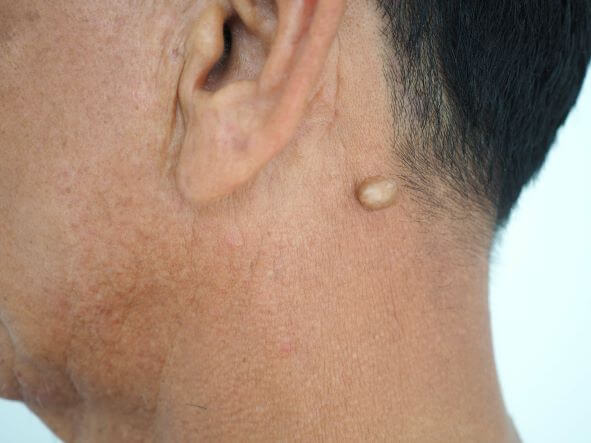Finding a lump under your skin can be a little frightening, but there are many completely benign explanations that you don’t need to panic about. According to Dr. Iviensan “Ivie” Manalo of U.S. Dermatology Partners in Peoria and Goodyear, Arizona, “If you find a lump under your skin, there’s no need to panic, but you should contact your dermatologist. It’s important to pinpoint the underlying cause of the lump and proceed with the appropriate treatment.” In this blog, Dr. Manalo reviews some of the most common causes of lumps under the skin as well as top recommended treatment options.
What Causes Lumps Under the Skin?
When it comes to lumps that form beneath the skin, learning the underlying cause is essential to ensure appropriate treatment. Dr. Manalo says, “When you first notice a lump under your skin, reach out to your dermatologist as soon as possible. During your consultation visit, your dermatologist will carefully examine the lump visually and manually. They may also need to run tests to more accurately diagnose the cause of the lump. Once your dermatologist understands the cause of the lump beneath your skin, they will walk you through your treatment options.”
Some of the common lumps that develop under the skin include:
- Lipomas – These are benign, fatty tumors that develop beneath the skin. The underlying cause of lipomas is unknown, but they do seem to have a genetic connection as many people who develop lipomas have one or more family members who also develop these lumps below the skin. Lipomas may also develop as a result of an injury.
- Cysts – A small, closed sac formed by skin tissue that fills with oil, skin cells, and other materials. Beneath the skin, the cyst usually feels soft, but the texture may differ depending on what materials have become trapped inside the sac and how deeply they develop. Cysts are common skin growths, and there are many different types, including ganglion cysts (hands and wrists), synovial cysts (spine), pilar cysts (scalp), mucous cysts (feet or mouth), and epidermoid cysts (skin follicles).
- Abscesses – A type of skin infection that may present as a large sore on the surface of the skin, but there is often a deeper lump of infection beneath the skin. Skin abscesses frequently develop because of an injury that becomes infected. An abscess can also occur when bacteria are trapped in hair follicles and sweat or oil glands.
- Swollen lymph nodes – Lymph nodes can become swollen, hardened, or enlarged in response to illness or damage. Most commonly this impacts the lymph nodes on the neck and below the arms, but they can form in any area where there are lymph nodes.
- Neurofibromas – This is a small, benign type of tumor that develops within nerves. The lumps are made up of an overgrowth of nerve cells as well as blood vessels, skin, fibers, and other types of cells and tissues.
- Dermatofibromas – Hard, noncancerous lumps beneath the skin that develop in the deep, dermis layers when excess skin cells clump together and create a bump beneath the skin. These growths are usually soft and movable.
- Boils – These inflamed lumps are caused by infection developing in one hair follicle or a group of connected follicles. The skin over the boil may be red, swollen, warm, and painful.
- Warts – These hard lumps typically develop on top of the skin, but they may also grow beneath the skin. Plantar warts, most often found on the foot, often grow deep beneath the skin.
- Keratoacanthoma – Often simplified to KA, this type of skin tumor has been closely linked to sun exposure, and while it is a form of skin cancer that looks similar to squamous cell carcinoma, these growths are benign.
- Skin cancer – A cancerous lump beneath the skin may vary in color compared with surrounding areas of skin and change in size or shape frequently.
When Should I Worry About Lumps Under the Skin?
When it comes to seeking treatment for lumps under the skin, Dr. Manalo says, “Not all lumps beneath the skin require immediate treatment. However, there are some situations where it’s important to seek treatment right away. Specifically, if you notice that the lump is changing or growing rapidly, schedule a visit with your dermatologist as soon as possible. Lumps under the skin that evolve quickly are common signs of skin cancer. Additionally, if the lump is painful, red, inflamed, bleeds or seeps fluid, or there are other warning signs of infection, it’s important to talk to a dermatologist. Even if the lump under your skin doesn’t require urgent treatment, it’s important to talk with a dermatologist to ensure the lump isn’t anything you need to be concerned about.”
How Are Lumps Under the Skin Treated?
Many lumps under the skin, if benign, will clear up on their own without specific treatment. When intervention is necessary, a dermatologist will help you determine the right treatment option based on your specific diagnosis. Some of the commonly recommended treatments include:
- Topical healing treatments – There are many skincare products and medicated ointments formulated to promote healing and recovery.
- Draining – Cysts, abscesses, and other skin infections may need to be professionally drained to relieve pressure. It is not medically advisable to attempt this at home as dermatologists have clean or sterile techniques to safely drain cysts, abscesses, or skin infections.
- Antibiotics – For swollen lymph nodes and other lumps beneath the skin caused by illness or infection, antibiotics may be prescribed to help fight the infection.
- Corticosteroid injections – A common treatment option for cysts and abscesses. This treatment relieves pain and jumpstarts the healing process.
- Surgical excision – In some cases, the lump will need to be surgically removed. This may be the case for some cysts, lipomas, and similar bumps beneath the skin.
How Do I Get Started Working with a Dermatologist?
When you’re ready to work with a dermatologist, it’s easy to schedule your first visit with a U.S. Dermatology Partners practice location near your home. Simply take a few moments to complete the online scheduling request form. Once a local office has received your scheduling request, they’ll be in touch to finalize the details of your visit.
Find a location near me
or


